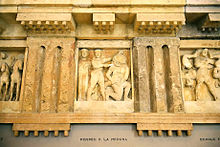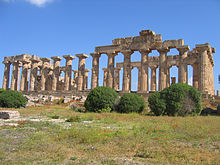Selinunte

Selinunte ( ancient Greek Σελινοῦς Selinous , Latin Selinūs and Selinuntum , Italian Selinunte ) is an archaeological site in the southern Italian Free Community Consortium Trapani in Sicily . The site is located in the municipality of Castelvetrano on the south coast of Sicily, directly on the Mediterranean .
The extensive site consists primarily of the remains of the ancient Greek city of Selinus, which was one of the most important poles in Sicily in ancient times . The numerous temples, which are among the most important Greek temples in Sicily , testify to this . Historically significant, although less impressive, are the ruins from the Carthaginian settlement phase of the place. Large parts of the ancient city have been exposed in the past few decades; one of the shrines, all of which were destroyed by earthquakes, was partially rebuilt (Temple E); however, the reconstruction does not correspond to the current state of research.
history
The Polis Selinunt was founded in the 7th century BC. Founded by Dorian Greeks from the eastern Sicilian Megara Hyblaea and existed for around 400 years. The city was the westernmost Greek planting city ( Apoikie ) on the south coast of the island. It was famous for its fertile soils, on which a particularly good wheat grew, and quickly achieved great wealth, which was particularly evident in the numerous large temples. In the 6th century, according to Polyainus (1,28,2), there was a tyranny under a certain Theron in Selinunt .
The city was a Carthaginian ally for a long time , primarily to secure support against Segesta . Selinunte was the only Greek city that existed in 480 BC. Fought on the side of Carthage in the battle of Himera . After that, the alliance seems to have been broken. The 5th century was the time of the greatest prosperity of the place. The eternal conflicts between the Greek Selinunte and the native settlement Segesta escalated in the following years and finally led to the intervention of the great powers Athens and Sparta , the latter supporting Syracuse and Selinunte against Athens. After Selinunt, after the failure of the Athens expedition to Sicily in 413 BC According to reports by Diodorus Siculus of Carthage in 409 BC , the city was “devastated” by Segestas. After a war with 16,000 dead and 5000 prisoners destroyed. The place was rebuilt by the Carthaginians ( Punic ). He got in the 4th century BC. Chr. Finally under Carthaginian control and was from then on almost exclusively inhabited by Carthaginians until Selinunt in the First Punic War 250 BC. Was evacuated and then destroyed by the Romans. This essentially ends Selinunt's story. However, there was obviously a certain continuity of settlement at a low level, and in late antiquity there was a small Christian place on the former acropolis.
Today volcanologists, archaeologists and historians suspect that the temples of the city, like other ancient cities on the Sicilian southwest coast, were destroyed due to an undersea earthquake in the Strait of Sicily and a huge tidal wave that triggered it . The dating is unclear, however.
Archeology and urban planning

The city was regularly laid out by the Greeks. The standardized street widths of 9 m, 6.5 m and 3.5 m are evidence of this. Each block was exactly 100 feet wide. The gutters were laid at right angles, and the first spiral staircase in history to date was found in one of the houses.
All of Selinunt's buildings and temples collapsed centuries ago due to earthquakes. One of them was rebuilt in 1956, but the reconstruction is very controversial. For years the DAI has been carrying out extensive excavations on the site of the ancient city.
The temples of Selinunts are characterized by an elongated floor plan, a closed rear cellar room ( Adyton ), the emphasis on the front by doubling the rows of columns, widening the spacing and an open staircase and show a tendency towards spatial expanse. However, this does not fall under the term Hypäthral Temple .
Richard Sennet writes in his book Handwerk : “According to the older layout plans, streets connected individual buildings, but the 624 BC. Selinus, founded by the Greeks in BC, was the purest cross between warp and weft. The intersection itself was emphasized as an important design element. The image of an 'urban fabric' was not a casual metaphor here, but a very direct description. On the other hand, Selinus had the strength and compactness of a ship. "
acropolis
The acropolis has four temples, plus well-preserved terraces and fortifications from the 4th century BC. One of the temples is Temple C (6 by 17 columns) from the middle of the 6th century BC. BC, which has been partially restored, another is the younger temple B. Here you will also find the remains of numerous typical Punic houses, which were mostly built on foundations of Greek buildings. The Carthaginians seem to have continued to use the Greek sanctuaries, but now for their own cult. For example, there are clear indications that Tanit was worshiped .
East hill and Demeter sanctuary
On the east hill in the east of the Acropolis, which was the most densely populated part of the city at that time, there are remains of 12 temples from the 6th and 5th centuries BC. Chr .; these include the temple E, presumably consecrated to the goddess Hera (around 460-450 BC), which stands on two previous structures and was restored as a Doric peripteros (6 times 15 columns), as well as that around 520 BC. Temple G, begun and unfinished in BC, which is one of the largest Greek temples with an area of 50 by 110 meters. A gable weighing 70 t was found in the rubble of these temples.
West of the Acropolis is the sanctuary of Demeter Malophoros from the 7th to 5th centuries BC. And a necropolis next to it .
Most of the finds from Selinunte are currently housed in the Regional Archaeological Museum of Palermo . These include:
- Carved metopes from Temple G (around 465–450 BC) and Temple C
- Bronze sculpture , the “ Ephebe von Selinunt ” from around 480 to 460 BC. Chr.
- Vases and terracottas from the sanctuary of Demeter Malophoros and the necropolis
Rocche di Cusa
Near Selinunt is the ancient Rocche di Cusa quarry , from which all the materials used to build the temples come. Here you can see how column drums, which were intended for the unfinished Temple G, were carved out of the rocks.
Todays use
The Selinunte Archaeological Park can now be visited by tourists. The ruins received special attention as a Google Camp 2019 venue with a performance by the band Coldplay . Also here were fashion shoots instead.
literature
- Holger Baitinger : Selinus V. The metal finds from Selinunt: the finds from the excavations of the German Archaeological Institute on the Agora (= special publications of the German Archaeological Institute Rome. Volume 19). Wiesbaden 2016.
- Holger Baitinger: Far away, so close! - Local and foreign in the mirror of the metal finds from Selinunt. In: Erich Kistler u. a. (Ed.): Sanctuaries and the Power of Consumbtion. Networking and the Formation of Elites in the Archaic Western Mediterranean World (= PHILIPPIKA. Volume 92). Harrassowitz, Wiesbaden 2015, pp. 137–151.
- Franco De Angelis: Megara Hyblaia and Selinous. The development of two Greek city-states in archaic Sicily (= Oxford University School of Archeology Monograph. Volume 57). Oxford 2003.
- Salvatore De Vincenzo: Between Greeks and Carthaginians. Contribution to the Punic identity of Selinunt in the context of Carthage's expansion policy in Sicily. In: Mediterraneo antico. Volume 17, number 1, 2014, pp. 235-267.
- Christopher A. Faraone, Dirk Obbink (Eds.): The Getty hexameters. Poetry, magic, and mystery in ancient Selinous. Oxford 2013.
- Luca Giuliani : The Archaic Metopes of Selinunt. Mainz 1979, ISBN 3-8053-0287-8 .
- Sophie Helas: Selinus II. The Punic city on the Acropolis (= special publications of the German Archaeological Institute Rome. Volume 15). Wiesbaden 2011.
- Marcus Heinrich Hermanns: The port facilities of Selinunt. Materials for researching the economic infrastructure of a western Greek coastal city. In: Communications of the German Archaeological Institute, Roman Department . Volume 120, 2014, pp. 99-134.
- Eckart Olshausen : Selinus 4. In: The New Pauly (DNP). Volume 11, Metzler, Stuttgart 2001, ISBN 3-476-01481-9 , Sp. 367-371.
- Anneliese Peschlow -Bindokat: The stone quarries of Selinunt. The Cave di Cusa and the Cave di Barone. Mainz 1990. ISBN 3-8053-1084-6
- Dieter Mertens : Selinus I. The city and its walls (= special publications of the German Archaeological Institute Rome. Volume 15). Philipp von Zabern, Mainz 2003, ISBN 3-8053-3248-3 .
- Gabriel Zuchtriegel : On the population of Selinunts in the 5th century BC Chr. In: Historia . Volume 60, 2011, pp. 115-121.
Web links
- Christoph Bühler: The Internet History Book - Selinunt
- Selinunte Archaeological Park
- Volcano of the sea depth
- The artisan district of Selinunte. The pottery workshop in Insula S16 / 17-E (excavation campaign by the Department of Classical Archeology at the University of Bonn 2010–2016)
- Selinunt - urban studies and history of a major Greek city (research project of the German Archaeological Institute, Rome department)
Coordinates: 37 ° 35 ′ 1 ″ N , 12 ° 49 ′ 29 ″ E
Individual evidence
- ↑ Selinunte Archeological Park. In: Visit Selinunte. Retrieved August 14, 2019 .
- ^ Matthias Rüb: 114 private jets for the climate summit. 864 tons of carbon dioxide for climate protection. In: Frankfurter Allgemeine. Gerald Braunberger, Werner D'Inka, Jürgen Kaube, Berthold Kohler, August 7, 2019, accessed on August 14, 2019 .
- ↑ Lee Marshall: Google Camp 2019. Is Sicily the new Davos? In: The Telegraph. Telegraph Media Group Ltd., August 2, 2019, accessed August 14, 2019 .
- ↑ Osman Ahmed: We spoke to an archaeologist about gucci's new campaign. Because it's set in the ruins of an Ancient Greek city. In: iD. Levelprint Ltd., Vice, April 26, 2019, accessed on August 14, 2019 .




